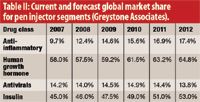Technology Forecast for Injectables
A Conversation with Greystone Associates' George Perros. This article contains bonus online-exclusive material.
This article is part of PharmTech's supplement "Injectable Drug Delivery."
The rise in novel biopharmaceuticals has injected new life into the injectable delivery market. The demand for injectable technologies is growing, says George Perros, managing director for Greystone Associates, a technology consultancy based in New Hampshire, which in September 2009 published an analysis on Drug Delivery for Self-Adminstration: Devices, Drugs, Product Strategies and Forecasts. The following interview with Perros describes this evolving market and recent innovations.
PharmTech» What is your overall assessment of the future for injectables?
»Perros: The advent of protein and peptide drugs has spurred the development of new delivery devices. Newer more fragile drug substances present a delivery challenge. Nevertheless, we see not so much a revolution in injectable devices, as an evolution, as these devices become increasingly more sophisticated, cost-effective, and safe.

Table I: Global historical volume and forecast for prefilled syringes (Greystone Associates).
PharmTech» What are the main drivers of this evolution?
»Perros: Typically, when these biological drugs are first released onto the market, they are administered by infusion by professional healthcare providers in a healthcare facility or an outpatient setting. This is an expensive way to administer drugs, but it allows these drugs to be used in a controlled setting until enough data are available to establish a safety profile for the drug that can be used to determine whether it should be approved in a form for self-administration.

Table II: Current and forecast global market share for pen injector segments (Greystone Associates).
The challenge that keeps driving device evolution focuses on how to get these drugs into the hands of the patients for self-administration in a way that is safe, reliable, and economical. For drug products designed for self-injection, this means injection devices that are prefilled (also referred to as combination products).
Another issue for biological drug developers is the fragile nature of the drugs themselves, which necessitates they be transported and stored at low temperature—the so-called 'cold chain'—which adds to the cost of distribution. To avoid the problem of temperature-dependent stability, proteins and peptides are often processed and packaged in dry or powder form. These lyophilized drugs must be reconstituted prior to injection. Special injection devices have been developed that contain two chambers, one with the lyophilized active ingredient, and the second for the formulation liquid or diluent. Upon activation, the powder and liquid are allowed to mix in the correct proportions, before being injected.
The ability of patients to self-medicate reduces the economic and resource pressure of having a healthcare professional administer the drug to the patient. So the technology challenge is to design a delivery device that ensures that the drug is preserved properly, reconstituted properly if necessary, and administered at the right dose by a person who may have little or no experience with injectable devices.
PharmTech» What kind of innovations are you seeing?
»Perros: The growth of reusable injectors with replaceable cartridges has been significant, particularly for drugs indicated for chronic conditions. Some of these devices allow the patient to adjust the dose. These are most often used for insulin administration, where the patient is adjusting the dose after measuring their blood glucose levels.
The arrival of disposable autoinjectors is an exciting development. Autoinjectors are pen-like devices that allow the user to insert a prefilled syringe and simplify the injection event. For years, this segment was dominated by reusable autoinjectors, which are made of durable materials but are a bit pricey. Recently, disposable autoinjectors have begun to appear. These less-expensive devices are providing drug marketers with new opportunities because they can be bundled or paired with a prefilled syringe. It's extending the utility and user-friendliness of autoinjectors to a growing number of patients who would otherwise need to master the art of injection with a naked prefilled syringe.
There have also been improvements in safety features for syringes used by healthcare providers. Retractable safety syringes, which are designed with needles that retract after injection to minimize the risk of needlestick injuries to care-givers, are starting to find traction in North America, and to a lesser degree, in Europe.
PharmTech» I see that the market for antivirals seems to have plateaued since 2007. Can you explain that trend? Which antivirals in particular are you focusing on?
»Perros: Interferons for infectious diseases, particularly Hepatitis C, are designed to boost the immune response to an infection. Because of difficulty with patient compliance due to side effects, this segment has experienced uneven growth. We expect that trend to continue.
PharmTech» The global market for pens containing insulin is trending up gradually. Do you see that growth coming from domestic or international growth primarily?
»Perros: Pens are already the most popular way to self-administer insulin in Europe. These devices are becoming more popular among diabetics in the US and this popularity will help overall growth in the near-term.
PharmTech» Are there any technologies that seem to be losing traction?
»Perros: Needle-free injectors continue to struggle. We think that this is because the current generation of pen injectors—with their quick and relatively painless operation and user friendly features—to a large extent obviate the need for needle-free devices.

Drug Solutions Podcast: A Closer Look at mRNA in Oncology and Vaccines
April 30th 2024In this episode fo the Drug Solutions Podcast, etherna’s vice-president of Technology and Innovation, Stefaan De Koker, discusses the merits and challenges of using mRNA as the foundation for therapeutics in oncology as well as for vaccines.